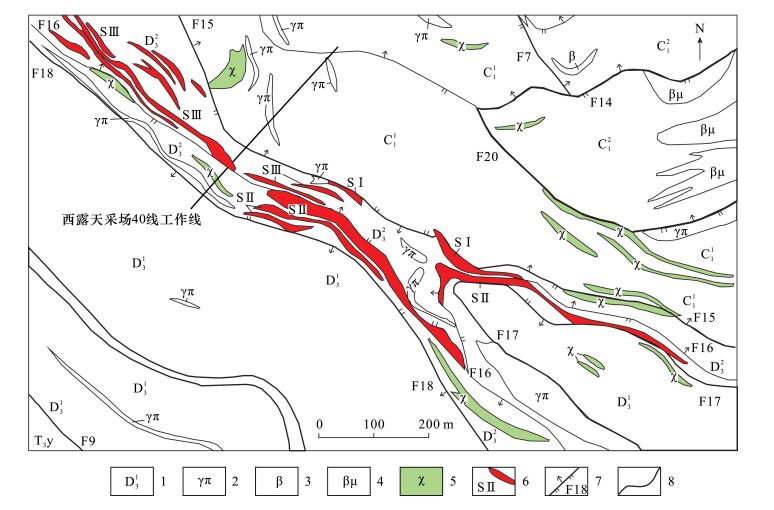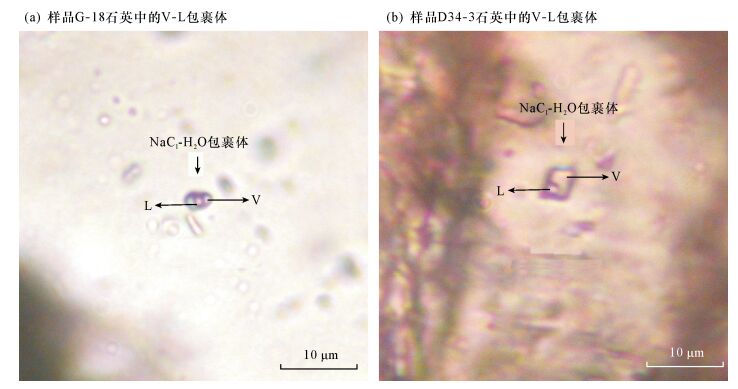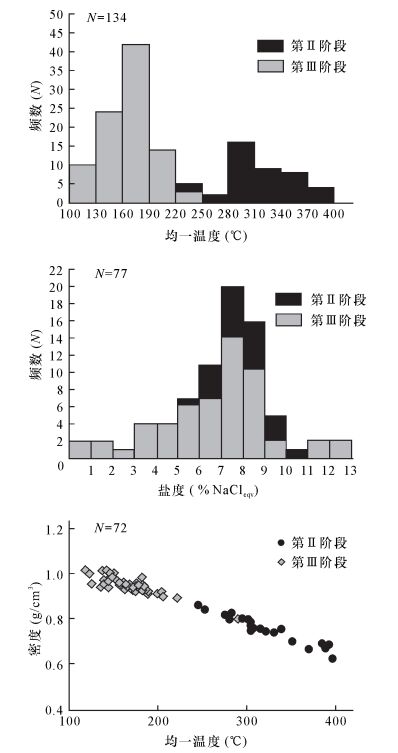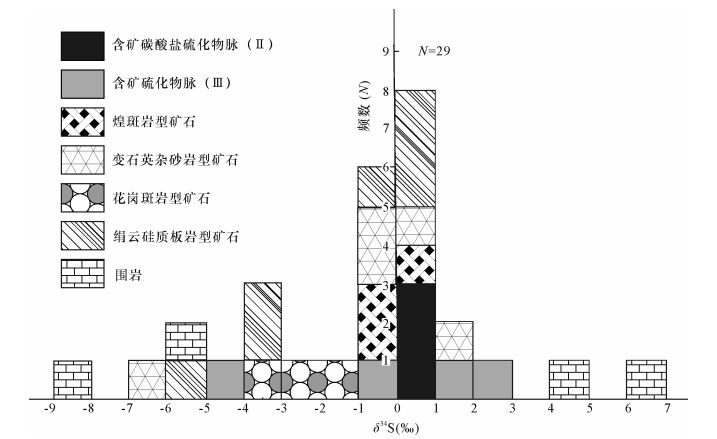Fluid Inclusion and Sulfur Isotope Study on the Donggualin Gold Deposit in the Ailaoshan Gold Belt
-
摘要: 流体包裹体和硫同位素研究可以揭示成矿流体特征和成矿物质来源,是探讨矿床成因的重要手段。冬瓜林金矿床位于哀牢山金矿带的镇沅金矿田,研究程度较低,矿床成因研究尚未系统开展。本文针对该矿床利用显微测温和硫同位素示踪,分别对两个金成矿阶段脉体中的流体包裹体和矿石中黄铁矿的硫同位素进行了测定,进而探讨其矿床成因。流体包裹体测试结果显示,流体体系为NaCl-H2O体系;包裹体的均一温度主要分布于100~400℃(有160~190℃和280~310℃两个峰值),盐度集中于6%~9%,密度集中于0.7~0.8 g/cm3和0.9~1.0 g/cm3,表明成矿流体为中低温度和低盐度的流体。硫同位素测试结果显示,两个金成矿阶段的δ34S值分别集中于0~1‰和-4.7‰~3‰,整体上与该矿床最主要的矿石——煌斑岩型矿石的δ34S值最为接近,且矿床中煌斑岩和金矿化关系最为密切,因此成矿物质可能主要来自与煌斑岩有关的幔源物质,但受到地壳物质的混染。综合上述结果认为,冬瓜林金矿床的形成可能与幔源含金流体有关,但有大气降水和围岩的加入,这一结论为揭示本矿床及哀牢山金矿带的矿床成因研究提供了重要依据。Abstract: Fluid inclusions and sulfur isotopes can reveal the characteristics of ore-forming fluid and the origin of ore-forming materials, which are important indicators for ore genesis. The Donggualin gold deposit is located in the Zhenyuan gold orefield of the Ailaoshan gold belt. Only a few studies have been carried out on this deposit and thus the ore genesis remains unsolved. Microthermometry of fluid inclusion in veins from two mineralization stages and sulfur isotope analyses of pyrite from ores has been studied, in order to unravel the ore genesis. Fluid inclusion results show that the ore-forming fluids belong mainly to the NaCl-H2O system and the homogenization temperatures range from 100℃ to 400℃, with two peak values of 160-190℃ and 280-310℃. The salinities peak at 6%-9% NaCleqv. The densities have two peaks of 0.7-0.8 g/cm3 and 0.9-1.0 g/cm3. These results suggest that the gold-forming fluids are characterized by mid-low temperature and low salinity. The δ34S values of pyrite from the two stages are 0-1‰ and -4.7‰-3‰, respectively, which are generally consistent with those of the lamprophyre wallrock (-0.44‰-0.54‰). The lamprophyre is very close to gold mineralization and lamprophyre-hosted ore is the most common. It can be inferred that the ore materials are probably related to the lamprophyre derived from mantle related to minor crustal contamination. In conclusion, the Donggualin deposit was possibly formed by mantle-derived gold-bearing fluids involved in meteoric water and wall rocks. This research provides an important clue for the ore genesis of the Donggualin gold deposit and gold deposits in the Ailaoshan gold belt.
-
Keywords:
- Donggualin gold deposit /
- fluid inclusion /
- sulfur isotope /
- mantle-derived fluid /
- microthermometry
-
金属同位素地球化学是相对于氢、碳、氧、硫等传统稳定同位素地球化学而言,包括铁、铜、锌、钼、镁、钛等同位素体系。与传统稳定同位素相比,金属同位素具有几个明显的地球化学特征:①这些元素多为微量元素,在不同地质储集层中浓度差异较大;②这些元素有高挥发性的元素(如Zn和K),也有难熔的元素(如Ca和Ti);③这些元素中有许多是氧化还原敏感元素;④其中许多具有生物必须的营养元素(如Cu和Zn)[1]。不同元素受不同的同位素分馏机制控制,使它们成为宇宙化学、地质和生物过程的独特示踪剂,为地球科学研究打开了新的窗口。例如,Mo同位素在示踪中元古代古海洋氧化还原状态中取得了一系列重要进展[2-4];Cd同位素显示了在示踪古海洋初级生产力中的潜力[5-6];Cr同位素在示踪地质历史时期大气氧含量中发挥了重要的作用[7-9]。
金属同位素分析包括样品处理和质谱测试。样品处理就是将样品转变成质谱可以测试的对象。具体而言,就是对样品进行消解并对待测元素进行提取、纯化和浓缩,使样品的待测组分转变成多接收器等离子体质谱(MC-ICP-MS)或热电离质谱(TIMS)可以测定的形式。如果样品处理方法不当,会使样品待测元素损失、基质去除不彻底,甚至引入新的杂质,使测试结果偏离真值。因此,样品处理是金属同位素分析中的重要环节。
本文阐述了金属同位素分析中样品处理的基本原则是不引入待测元素以及可能会对待测元素同位素分析产生干扰的元素;且待测元素不发生损失;常用的消解方法是酸溶法;常用的化学分离方法是离子交换分离法。此外,结合本文作者在实际工作中的积累,提出在样品处理过程需要注意的一些细节,以促进金属同位素分析技术的提高。
1. 金属同位素分析中样品处理的基本原则
金属同位素分析中的样品处理主要包括两个过程:样品的消解;样品中待测元素的分离纯化。为了获得真实、准确的金属同位素数据,样品处理过程中必须遵守两个基本原则:①不引入待测元素以及可能会对待测元素同位素分析产生干扰的元素。因此,样品处理过程中使用的试剂和器皿必须足够干净。如使用的酸必须是超纯酸;使用器皿的材质通常是聚四氟乙烯(PFA)、聚丙烯(PP)和石英材质;②待测元素不发生损失。地质和环境样品必须彻底溶解,并且在分离纯化过程中回收率尽可能达到全回收(~100%)。
2. 金属同位素分析中样品的消解方法
地质和环境样品常用的消解方法包括:酸溶解法、熔融法和烧结法(半熔法)、高压闷罐法和微波消解法[10-12]。高压闷罐法和微波消解法本质上都是一种酸溶法。熔融法和烧结法(半熔法)都要使用助熔剂,助熔剂不易提纯,其本身所含金属元素和无法去除的杂质,都可能会影响同位素测定结果,并不适用于金属同位素的样品消解。酸溶法只使用超纯酸,在样品处理过程中不引入阳离子。因此,金属同位素分析中的样品消解通常采用酸溶法。有机质会影响之后的分离纯化过程[13],故消解结束的样品中不能含有有机质。在满足质谱测试需要的前提下,消解的样品量尽可能地少,这样可以减少试剂用量并缩短消解时间,从而降低本底、提高工作效率。但当消解的样品量太少时,来自于样品处理过程中所用试剂、离子交换树脂等杂质引起的基质效应相对更显著[14],导致同位素分析结果不能反映真值。消解样品时还需要考虑样品的代表性,如果样品不够均匀,消解的样品量太少,可能导致测试结果不能反映样品的真值。
2.1 常见岩石样品的消解方法
2.1.1 硅酸盐岩样品
硅酸盐岩样品一般使用硝酸-氢氟酸消解。消解时先在样品中加入少量硝酸润湿样品,然后加入氢氟酸后拧紧瓶盖,超声或手动摇匀样品,最后将溶样杯置于120℃的电热板上加热溶解。硝酸与氢氟酸的比例根据样品的SiO2含量确定。当样品中的铝含量较高时可加入高氯酸蒸发,再用盐酸溶解剩余残渣。当样品中含有较多难溶矿物时,可以采用高压闷罐法[15]。
2.1.2 碳酸盐样品
碳酸盐矿物(如方解石、白云石、菱镁矿等)和较纯的碳酸盐岩石,可以直接使用盐酸溶解。
2.1.3 铁矿石和金属矿物样品
铁矿石样品通常使用盐酸-水(体积比1:1)加热进行消解。消解黄铁矿可用少量硝酸,在样品中加入硝酸后,待产生的气体挥发完后再拧紧瓶盖。含铁的硅酸盐岩样品需加入氢氟酸才能使样品完全分解。王水可以分解大部分金属的硫化物、铜矿石、钨矿石等矿物。逆王水用于形式为MeS的许多金属硫化物矿物的分解[10]。
2.1.4 含有机质样品
页岩、泥岩等有机质含量高的样品,通常先低温炭化(即100~105℃烘干)去除样品中的水分及挥发物质,再通过干灰化法去除样品中的有机质,最后用硝酸、盐酸、氢氟酸等溶解剩余的灰分[16]。灰化温度高、时间长,去除有机质彻底,但会使易挥发的待测元素损失,同时导致待测元素发生同位素分馏[17];灰化温度低、时间短则会使灰化不完全,残存的小碳颗粒易吸附某些金属元素,很难用常用酸溶解。因此在使用干灰化法前,必须通过实验确定灰化的温度和时间等条件,确保在此条件下灰化不会造成待测元素同位素发生分馏。消解有机质含量低的样品时,可以在样品中加入强氧化剂(浓硝酸、王水、逆王水、高氯酸和过氧化氢)并加热,使样品中的有机物转化为无机物[18]。
2.1.5 环境样品
金属同位素研究的环境样品,主要包括地表淡水、地下淡水、海水以及这些水体的颗粒物、悬浮物和沉积物。此类样品首先需要用0.20μm的微孔滤膜过滤,将颗粒物、悬浮物、沉积物与淡水、海水分开。颗粒物等固体样品需要先烘干再按照含有机质的样品进行处理[19]。海水中含量高的元素(如Ca和Mg)可以直接蒸干,使用常规酸消解[20-22];海水中含量低的元素需要进行脱盐和富集。不同的元素使用不同的脱盐、富集方法,如Cr元素使用与Fe共沉淀的方法[23]。淡水样品通常在蒸干后使用盐酸进行消解[24]。
2.2 样品消解需要注意的问题
(1) 当使用微波消解有机质含量高的样品后,消化液看似清澈,其实含有很多胶质,需要进一步去除有机质才能进行分离纯化[25]。
(2) 根据本文作者经验,如果消解样品时使用了高氯酸,必须将高氯酸在高温下彻底去除,因为残余的高氯酸具有强氧化性会导致化学分离使用的离子交换树脂失效,影响其分离效果。
3. 样品中待测元素的分离纯化方法——离子交换分离法
在样品消解之后和使用质谱仪分析金属同位素之前,须将消解后样品的待测元素与基质分离,同时富集待测元素。常用的分离纯化方法包括:沉淀和共沉淀、溶剂萃取、离子交换、色谱和电化学分离等。目前,绝大部分金属同位素分析的分离纯化都采用离子交换分离法。该方法的优点是:①使用的容器便于清洗;②大多数树脂可重复使用;③操作方便,交换容量可变;④试剂易于提纯且用量少,流程的空白相对于其他方法比较低[26]。也有一些元素采用其他方法,如Se同位素采用巯基棉分离技术[27],Hg同位素采用在线汞蒸气发生系统[28]。这些方法仅适用于特定元素的化学纯化,与离子交换分离法没有共性。因此,本文不作详细阐述。
样品分离纯化最理想的情况是将所有基质的阳离子彻底去除,接收液中只包含待测元素一种金属阳离子,并且待测元素达到接近100全回收。但离子交换分离法的实际情况是很难达到这样的效果。因此,首要考虑的就是彻底去除其中会对待测元素同位素分析产生同质异位素干扰和基质效应的元素。例如,分析Cd同位素时,必须把Mo在离子交换中彻底去除,因为98Mo16O+会对114Cd产生同质异位素干扰[29]。如果某种元素在离子交换中可以回收大部分待测元素但达不到全回收,且该元素有4个或4个以上同位素时,可以采用双稀释剂法校正离子交换过程中发生的同位素分馏[30-31]。
3.1 离子交换树脂的类型和主要参数
离子交换树脂是一种高分子聚合物,具有网状结构。网状结构的骨架上有许多可以与溶液中的离子起交换作用的活性基团。根据活性基团,离子交换树脂分为阳离子交换树脂和阴离子交换树脂[32]。阳离子交换树脂的活性基团是酸性基团,分为强酸性基团(如磺酸基,—SO3H)等)和弱酸性基团(如羧基,—COOH等),与溶液中的阳离子交换。阴离子交换树脂的活性基团是碱性基团,分为强碱性基团[如季胺基,—N(CH3)3等]和弱碱性基团(如胺基,—NH2等),与溶液中的阴离子交换。除此以外,还有螯合树脂和特效树脂。螯合树脂是将高选择性的有机试剂引入树脂骨架,此类树脂具有高选择性和稳定性。在化学分离时,树脂上同时发生离子交换和螯合反应。特效树脂包括冠醚树脂和萃淋树脂,冠醚树脂对碱金属和碱土金属元素等有特殊的选择性。树脂在吸附阳离子的同时也伴随着吸附等量阴离子,以保持电中性,故此类树脂可用于阴阳离子的分离。萃淋树脂是将常用的酯类或芳香族等萃取剂附着在以苯烯-二乙烯为骨架的大孔径结构上形成的共聚物,对金属离子的选择性取决于所含的萃取剂[33]。
离子交换树脂的主要参数包括:①交联度,指树脂中所含交联剂的质量分数。交联度代表网状结构的紧密程度和孔径大小。树脂的交联度大,网眼小,交换的选择性高,对水的溶胀性小,交换速度慢。树脂的交联度以符号“X-”表示,通常为X-4至X-12,即表示树脂的交联度为4%~12%。②粒度,指树脂颗粒的大小,通常以筛的网目或直径表示,如100目(150μm)和200目(75μm)。树脂颗粒小,交换速度快,但若颗粒太小,淋洗液的流速会减慢。③交换容量,指每克干树脂所能交换离子物质的量(mmol),由树脂网状结构中所含活性基团的数目决定,可通过实验方法利用酸碱滴定原理测得。树脂的交换容量一般为3~6mmol/g。④亲和力,指离子在交换树脂上的交换能力。亲和力与水合离子的半径、电荷和离子的极化程度有关,水合离子的半径越小,电荷越高,离子的极化程度越大,亲和力就越大[12]。
3.2 离子交换分离法的工作过程
离子交换分离法是利用离子交换剂与溶液中离子发生交换反应进行元素分离的方法[32-34]。样品溶液流经交换柱中的树脂层时,由上至下一层一层地发生交换,由于树脂与溶液中不同离子的亲和力不同,形成不完全重叠的吸附带。选择适当的淋洗剂(也称洗脱剂或洗提剂),通过反复解吸和吸附过程,随着淋洗剂不断流过,元素的吸附带被逐渐分开,不同元素依次洗脱,此过程称为淋洗过程(也称洗脱过程)。这种方法既能用于带相反电荷离子间的分离,也可用于带相同电荷离子间的分离,甚至可以用于某些性质相近的离子之间的分离(如Ti、Zr、Hf之间的分离,稀土元素之间的分离)[32]。离子交换树脂和淋洗剂的种类与浓度都是决定分离效果的主要因素[35]。一般应用于金属同位素分析的离子交换分离多以无机酸作为淋洗剂,有时为改善分离效果可使用两种酸的混合酸。
3.3 部分金属同位素分析常用的离子交换方法
部分金属元素所使用的离子交换树脂和树脂用量汇总于表 1。由表 1可知,相同的树脂可以用于不同元素的化学分离。例如AG1-X8树脂可以用于Fe、Mo和Cd的离子交换分离。同一种元素也可以使用不同的树脂进行化学分离,如Fe的分离纯化既可以使用AG1-X8树脂,也可以使用AG MP-1树脂。AG MP-1与AG1-X8惟一的区别是AG MP-1的孔径大[36]。当只需要分离样品中的Fe时,可以使用树脂柱(长2.0cm,内径0.8cm)中装入1mL AG1-X8树脂[37]。当需要同时分离纯化样品中的Cu和Fe时,需要在很长的树脂柱(长10.5cm,内径0.62cm)中装入3mL AG1-X8树脂[38]。当需要同时分离纯化样品中的Fe、Cu和Zn时,只需在树脂柱(长0.68cm,内径4.3cm)中装入1.6mL AG MP-1树脂[39-40]。
表 1 部分金属元素稳定同位素分析中常用的离子交换树脂及用量Table 1. Ion exchange resin and the volume of resin commonly used in metal element stable isotope analysis分析元素 方法 分离步骤 树脂(粒径),类型 树脂量(内径×高) 参考文献 Cu,Fe,Zn 方法一 一步 AG MP-1 (74~147μm), Cl-型 0.68cm×4.0cm Maréchal等[39],唐索寒等[40] Cu,Fe 方法一 一步 AG1-X8 (38~74μm), Cl-型 0.62cm×10.5cm Tang等[38] Fe 方法一
方法二一步
一步AG1-X8 (38~74μm), Cl-型
AG1-X4 (38~74μm), Cl-型0.8cm×2.0cm
0.35cm×2cmDauphas等[37]
唐索寒等[46]Mg 方法一 第一步
第二步AG 50W-X12 (38~74μm), H+型
AG 50W-X12 (38~74μm), H+型0.3cm×18cm
0.3cm×3.5cmChang等[47] 方法二 第一步
第二步AG 50W-X12 (38~74μm), H+型
AG 50W-X12 (38~74μm), H+型0.39cm×10cm
0.39cm×2cm李世珍等[48] 方法三 第一步
第二步AG MP-1M (74~150μm), Cl-型
AG 50W-X12 (38~74μm), H+型0.6cm×4cm
0.6cm×8.4cmBolou-Bi等[49] Ca 方法一 第一步
第二步Dowex 50W-X8 (38~74μm)
Dowex 50W-X4 (38~74μm)1.0cm×30cm
少量Marshall等[50] 方法二 一步 Temex 50W-X8 (38~74μm) 0.6cm×3.5cm Schmitt等[22] 方法三 两步 AG 50W-X12 (38~74μm) 0.3cm×11cm He等[51] Mo 方法一 第一步
第二步AG1-X8 (74~147μm), Cl-型
AG 50W-X8 (38~74μm), H+型0.6cm×34cm
0.6cm×12.5cmPietruszka等[52] 方法二 一步 AG1-X8 (74~147μm), Cl-型 0.68cm×4.3cm Pearce等[53],
Li等[54]Cd 方法一 第一步
第二步
第三步AG 1-X8 (74~147μm), Cl-型
AG 1-X8 (74~147μm), Cl-型
TRU1.5mL
100μL
100μLRipperger等[45] 方法二 一步 AG MP-1 (74~147μm), Cl-型 0.68cm×4.1cm Cloquet等[43],
100μL张羽旭等[44]Cr 方法一 一步 AG1-X8 (74~147μm), Cl-型 2mL Schoenberg等[55] 方法二 一步 AG 50W-X8 (38~74μm), Cl-型 0.64cm×9.0cm Bonnand等[23] 方法三 第一步
第二步
第三、四步AG1-X4 (38~74μm), Cl-型
AG 50W-X8 (38~74μm), Cl-型
TODGA2mL
2mL
0.75mLSchiller等[56] 方法四 第一步
第二步Ln Spec resin
AG1-X8 (74~147μm), Cl-型a2mL
1.5mLLi等[57] Ti 方法一 第一步
第二步
第三步AG1-X8 (74~147μm), Cl-型
U/TEVA
AG1-X8 (74~147μm), Cl-型0.68cm×2.0cm
0.3cm×2.5cm
0.68cm×2.0cmMakishima等[58],
0.3cm×2.5cm唐索寒等[59]方法二 第一步
第二步TODGA
AG1-X8 (38~74μm), Cl-型0.8cm×4.0cm
0.32cm×10cmZhang等[60],唐索寒等[41],Hibiya等[61] 方法三 第一步
第二步Ln-spec (50~100μm)
AG 50W-X12 (38~74μm)0.7cm×6cm
0.7cm×3.5cmHe等[62] 注:分离步骤是指同一个交换柱、同一树脂,使用相同或不同淋洗剂为一步。 不同类型样品的基质差异较大,需要不同的流程对待测元素进行分离。在交换柱规格、树脂填充量和淋洗剂相同的情况下,基质相对单一的样品(如碳酸盐、单矿物)分离时,待测元素洗脱比较靠前、集中;当样品基质元素含量过高、待测元素含量很低时,有可能导致待测元素直接被洗脱,这种情况必须要格外慎重[41]。当研究人员不确定被分析样品的基质对待测元素分离的影响时,可以按照参考文献的方法进行分离,将被测元素接收液及其前后1mL的淋洗液分别收集,进行检测,计算回收率,从而判断文献的分离方法是否适用于所研究的对象。当不适用于所研究的对象时,可以通过改变分离流程(包括:改变树脂的用量,变换淋洗液或用量,增加分离步骤等方法)来满足不同样品的分离要求。例如,Maréchal等[39]建立的Fe、Cu、Zn分离流程对于大多数地质样品都适用,但是对于富钴结壳样品需要改变淋洗液盐酸的浓度实现Cu与Co的分离[42]。分离一般岩石样品中的Ti,需两步分离;而对于高Mg/Ti的橄榄岩样品,就需要三步分离[41]。分离一般岩石样品中的Cd,只需要一步分离[43-44];而分离海水样品中的Cd,就需要三步分离[45]。
3.4 离子交换分离中需要注意的问题
(1) 装树脂:装树脂柱时,需要在溶液自然流动的情况下加入树脂(有的需要振动,加速树脂下沉并防止树脂柱中有气泡),一批树脂柱中树脂的疏密程度尽量保持一致。
(2) 树脂的用量:同一体积的树脂放入不同内径的交换柱中,树脂床高度是不同的,淋洗流程也不一样。根据本文作者实际经验,树脂柱越细越长,淋洗液流速越慢、洗脱时间越长,并且待测元素洗脱出来滞后。
(3) 树脂柱的再生:部分金属元素分离使用的树脂是可以重复使用的,树脂再生(使用过的树脂恢复至初始状态的过程)所使用的溶液和体积需要经过实验确定。
(4) 树脂柱的淋洗:根据本文作者经验,进行离子交换分离时,在总淋洗液体积一定时,每次加入的试剂体积越小,淋洗出来的元素越集中,分离效果越好。
4. 金属同位素分析的发展方向
随着金属同位素应用范围的扩大和研究深度的增加,金属同位素分析发展的趋势是:①从普通的地质、环境样品具体到特殊的地质、环境样品的金属同位素分析[42, 63-64];②从地质、环境样品拓展到生物样品和人体组织的金属同位素分析[65];③从全岩细化到不同相态、不同矿物的金属同位素分析[5, 66-67];④从微量金属同位素分析扩大到痕量金属同位素分析[29, 68]。因此,在待测样品类型越来越多元、样品的基质越来越复杂、待测元素含量越来越低的情况下,在不引入待测元素以及干扰元素和不损失待测元素的原则下,样品处理也需要注意更多的细节,才能做到对待测样品低空白、高效率的消解和化学分离纯化。
本文总结了金属同位素分析样品中处理的原则、消解样品的方法、分离纯化待测元素的方法,并根据本文作者工作经验提出了在样品处理中需要注意的一些细节,以期对提高金属同位素分析水平、获得更高质量的分析数据有参考和借鉴意义。
致谢: 本文野外工作得到中国地质大学(北京)袁琴和王晓同学的大力支持,文章撰写过程中获得中国科学院地球化学研究所蓝廷广博士的很大帮助,在此一并表示感谢。 -
表 1 冬瓜林金矿床主要成矿阶段流体包裹体的显微测温结果
Table 1 Microthermometric properties of fluid inclusions from major mineralization stages in Donggualin gold deposit
样品
编号热液活动
阶段寄主
矿物均一温度范围
(℃)测试数
(个)均一温度
平均值(℃)冰点温度范围
(℃)测试数
(个)盐度范围
(%NaCleq)样品
编号0样品
编号1D-1 Q 327 1 327 - - - - D-10 D14 Q 297~(>550) 2 307.5 -5.7~-4.7 2 7.5~8.8 2 D140 D29-2 Q 337~342 2 339.5 -6.5 1 9.9 1 D29-20 D31-2 Q 340~399 6 380.33 -5.1~-4.9 2 7.7~8.0 2 D31-20 D32-1 Cal 247~307 6 274.7 -4.2~-3.1 3 5.1~6.7 3 D32-10 D33-4 Ⅱ Q, Cal 280~(>550) 9 315.7 -5.2~-4.8 5 7.5~8.0 D33-40 D33-41 G-6 Cal 284~289 2 286.5 -5.4 1 8.4 1 G-60 G-10 Q 298~324 3 310 -4.3 1 6.9 1 G-100 G-18 Q 248~319 5 291.8 -5.4~-4.4 2 7.0~8.4 2 G-180 G-24 Q 352~396 5 379.6 -7.6~-6.6 3 10.0~11.2 3 G-240 G-31 Q 281~(>550) 2 294.5 -3.7 1 6.0 1 G-310 D-5 Q 118~275 22 171.4 -8.5~-4.1 15 6.6-12.6 15 D-50 D-09 Q 113~203 38 163.6 -6.6~-2.0 12 3.4~10.0 12 D-090 D34-3 Ⅲ Q, Cal 171~292 13 229.7 -5.7~-4.3 4 6.9~8.3 D34-30 D34-31 G-9 Q 127~189 23 164.2 -5.6~-0.5 21 8.7~0.9 21 G-90 G-25 Cal, Q 172~302 6 193.0 -3.5~-2.7 4 4.45~5.7 4 G-250 注:Q—石英,Cal—方解石;“-”表示未能测试出或计算出的数据;“>550”表示测试时均一温度超过550℃, 此类数据未统计和计算在内。 表 2 冬瓜林金矿床硫同位素分析结果
Table 2 δ34S values of S isotope in samples from Donggualin gold deposit
样品编号 热液活
动阶段δ34S测试值
(‰)δ34S平均值
(‰)样品名称 数据
来源G-5 Ⅱ 0.622 0.794 含矿碳酸盐
硫化物脉本文
1*D-23-1 0.851 D-28-1 0.910 G-1
Ⅲ2.685
-0.380
含矿硫化
物脉G-3 1.297 L1633 S32-5 -4.700
本文
2*L1633 1236 -0.800 LTZ25 / 0.540 -0.007 煌斑岩型矿石 文献
[21]LTZ29 -0.120 LTZ-2 -0.440 SBT1 / 0.90 -1.348 变石英杂
砂岩型矿石镇沅金矿
田冬瓜林
矿段详细
普查地质
报告
(1993)LTZ27 -6.79 LTZ-4 -0.86 LRZ1 -0.17 LRZ2 0.18 StW4 / -2.23 -2.440 花岗斑岩型
矿石SRZ1 -1.65 SRZ10 -3.44 SRZ9 / -0.75 -1.704 绢云硅质
板岩型矿石LTZ30 0.16 DF4 0.15 DF6 -3.23 LTZ-6 -5.57 STW17 -3.26 绢云硅质板岩型
矿石(灰岩型)LTZ26 0.57 LTZ34 / -8.38 -0.803 围岩(灰岩)
围岩(杂砂岩)围岩(灰岩)LTZ36 4.04 LTZ37 6.70 LTZ-8 / -5.57 -0.803 围岩(含碳绢云
硅质板岩)文献
[21]注:本文1*数据测定单位为中国科学院地质与地球物理研究所岩石圈演化国家重点实验室稳定同位素实验室; 本文2*数据测试单位为中国地质科学院国土资源部同位素实验室; “/”表示前人无此项说明。 -
陈永清, 黄静宁, 卢映祥, 等.中缅毗邻区金腊Pb-Zn-Ag多金属矿田元素、稳定同位素和流体包裹体地球化学[J].地球科学——中国地质大学学报, 2009, 34(4):585-594. http://www.cnki.com.cn/Article/CJFDTOTAL-DQKX200904004.htm Chen Y Q, Huang J N, Lu Y X, et al.Geochemistry of elements, sulphur-lead isotopes and fluid inclusions from Jinla Pb-Zn-Ag poly-metallic ore field at the joint area across China and Myanmar border[J].Earth Science-Journal of China University of Geosciences, 2009, 34(4):585-594. http://www.cnki.com.cn/Article/CJFDTOTAL-DQKX200904004.htm
付伟, 柴明春, 杨启军, 等.广西佛子冲大型铅锌多金属矿床的成因:流体包裹体和H-O-S-Pb同位素地球化学约束[J].岩石学报, 2013, 29(12):4136-4150. http://www.cnki.com.cn/Article/CJFDTOTAL-YSXB201312007.htm Fu W, Chai M C, Yang Q J, et al.Genesis of the Fozichong Pb-Zn polymetallic deposit:Constraints from fluid inclusions and H-O-S-Pb isotopic evidences[J].Acta Petrologica Sinica, 2013, 29(12):4136-4150. http://www.cnki.com.cn/Article/CJFDTOTAL-YSXB201312007.htm
倪培, 范宏瑞, 丁俊英.流体包裹体研究进展[J].矿物岩石地球化学通报, 2014, 33(1):1-5. http://www.cnki.com.cn/Article/CJFDTOTAL-KYDH201401001.htm Ni P, Fan H R, Ding J Y.Progress in fluid inclusions[J].Bulletin of Mineralogy, Petrology and Geochemistry, 2014, 33(1):1-5. http://www.cnki.com.cn/Article/CJFDTOTAL-KYDH201401001.htm
孙晓明, 莫儒伟, 翟伟, 等.藏南沙拉岗锑矿流体包裹体红外显微测温研究[J].岩石学报, 2014, 30(1):189-198. http://www.cnki.com.cn/Article/CJFDTOTAL-YSXB201401014.htm Sun X M, Mo R W, Zhai W, et al.Infrared fluid inclusion microthemometry on stibnite from Shalagang antimony ore in Southern Tibet, China[J].Acta Petrologica Sinica, 2014, 30(1):189-198. http://www.cnki.com.cn/Article/CJFDTOTAL-YSXB201401014.htm
张潮, 刘育, 刘向东, 等.胶西北新城金矿床硫同位素地球化学[J].岩石学报, 2014, 30(9):2495-2506. http://www.cnki.com.cn/Article/CJFDTOTAL-YSXB201409004.htm Zhang C, Liu Y, Liu X D, et al.Characteristics of sulfur isotope geochemistry of the Xincheng gold deposit, Northwest Jiaodong, China[J].Acta Petrologica Sinica, 2014, 30(9):2495-2506. http://www.cnki.com.cn/Article/CJFDTOTAL-YSXB201409004.htm
贾丽琼, 徐文艺, 杨丹, 等.江西九瑞地区东雷湾矽卡岩型铜多金属矿床流体包裹体特征及稳定同位素地球化学研究[J].岩石矿物学杂志, 2015, 34(2):184-204. http://www.cnki.com.cn/Article/CJFDTOTAL-YSKW201502005.htm Jia L Q, Xu W Y, Yang D, et al.Fluid inclusion characteristics and stable isotope geochemistry of the Dongleiwan skarn Cu polymetallic deposit in the Jiujiang-Ruichang metallogenic area, Jiangxi Province[J].Acta Petrologica et Mineralogica, 2015, 34(2):184-204. http://www.cnki.com.cn/Article/CJFDTOTAL-YSKW201502005.htm
卢焕章, 单强.金属矿床的成矿流体成分和流体包裹体[J].岩石学报, 2015, 31(4):1108-1116. http://www.cnki.com.cn/Article/CJFDTOTAL-YSXB201504018.htm Lu H Z, Shan Q.Composition of ore forming fluids in metal deposits and fluid inclusion[J].Acta Petrologica Sinica, 2015, 31(4):1108-1116. http://www.cnki.com.cn/Article/CJFDTOTAL-YSXB201504018.htm
王洋洋, 肖益林, 杨晓勇.长江中下游成矿带铜陵新桥矿床Re-Os同位素及流体包裹体研究[J].岩石学报, 2015, 31(4):1031-1039. http://www.cnki.com.cn/Article/CJFDTOTAL-YSXB201504011.htm Wang Y Y, Xiao Y L, Yang X Y.Re-Os isotope systematics and fluid inclusions of Xinqiao deposit in Tongling, the middle-lower Yangtze River metallogenic belt[J].Acta Petrologica Sinica, 2015, 31(4):1031-1039. http://www.cnki.com.cn/Article/CJFDTOTAL-YSXB201504011.htm
赵静, 梁金龙, 倪师军, 等.甘肃阳山金矿载金黄铁矿硫同位素Nano-SIMS原位分析[J].矿床地质, 2016, 35(4):653-662. http://www.cnki.com.cn/Article/CJFDTOTAL-KCDZ201604002.htm Zhao J, Liang J L, Ni S J, et al.In situ sulfur isotopic composition analysis of Au-bearing pyrites by using nano-SIMS in Yangshan gold deposit, Gansu Province[J].Mineral Deposit, 2016, 35(4):653-662. http://www.cnki.com.cn/Article/CJFDTOTAL-KCDZ201604002.htm
丁矢勇.论老王寨金矿田(段)地球化学特征[J].云南地质, 1995, 14(3):206-215. http://www.cnki.com.cn/Article/CJFDTOTAL-YNZD503.003.htm Ding S Y.Discussion on the geochemical characteristics of Laowangzhai gold ore field[J].Yunnan Geology, 1995, 14(3):206-215. http://www.cnki.com.cn/Article/CJFDTOTAL-YNZD503.003.htm
张闯, 杨立强, 赵凯, 等.滇西哀牢山老王寨金矿床控矿构造样式[J].岩石学报, 2012, 28(12):4109-4124. http://www.cnki.com.cn/Article/CJFDTOTAL-YSXB201212024.htm Zhang C, Yang L Q, Zhao K, et al.Structure controlling pattern of the Laowangzhai gold deposit, Ailaoshan orogenic belt, Western Yunnan, China[J].Acta Petrologica Sinica, 2012, 28(12):4109-4124. http://www.cnki.com.cn/Article/CJFDTOTAL-YSXB201212024.htm
黄智龙, 刘从强, 朱成明, 等.云南老王寨金矿区煌斑岩成因及其与金矿化的关系[M].北京:地质出版社, 1999:1-252. Huang Z L, Liu C Q, Zhu C M, et al.The Origin of Lamprophyres in the Laowangzhai Gold Field, Yunnan Province and Their Relations with Gold Mineralization[M].Beijing:Geological Publishing House, 1999:1-252.
梁业恒, 孙晓明, 石贵勇, 等.云南哀牢山老王寨大型造山型金矿成矿流体地球化学[J].岩石学报, 2011, 27(9):2533-2540. http://www.cnki.com.cn/Article/CJFDTOTAL-YSXB201109005.htm Liang Y H, Sun X M, Shi G Y, et al.Ore-forming fluid geochemistry and genesis of Laowangzhai large scale orogenic gold deposit in Ailaoshan gold belt, Yunnan Province, China[J].Acta Petrologica Sinica, 2011, 27(9):2533-2540. http://www.cnki.com.cn/Article/CJFDTOTAL-YSXB201109005.htm
Zhao Y, Wang Q F, Sun X, et al.Characteristics of ore-forming fluid in the Zhenyuan gold orefield, Yunnan Province, China[J].Journal of Earth Science, 2013, 24(2):203-211. doi: 10.1007/s12583-013-0323-4
何文举.镇沅金矿田围岩蚀变与成矿系列[J].云南地质, 2002, 21(2):121-133. http://www.cnki.com.cn/Article/CJFDTOTAL-YNZD200202001.htm He W J.Wallrock alteration and metallongenic series of Zhenyuan Au ore field[J].Yunnan Geology, 2002, 21(2):121-133. http://www.cnki.com.cn/Article/CJFDTOTAL-YNZD200202001.htm
沈上越, 魏启荣, 程惠兰, 等.云南哀牢山金矿带成因类型探讨[J].特提斯地质, 1997(21):73-84. http://www.cnki.com.cn/Article/CJFDTOTAL-TTSD721.005.htm Shen S Y, Wei Q R, Cheng H L, et al.An approach to genetic types of the gold deposits in the Ailaoshan gold ore belt, Yunnan[J].Tethyan Geology, 1997(21):73-84. http://www.cnki.com.cn/Article/CJFDTOTAL-TTSD721.005.htm
周向科, 王建国, 易锦俊, 等.云南冬瓜林金矿床的围岩蚀变特征和成矿阶段划分[J].中国矿业, 2016, 25(增刊):285-288. http://www.cnki.com.cn/Article/CJFDTOTAL-ZGKA2016S1072.htm Zhou X K, Wang J G, Yi J J, et al.Wall rock alteration and ore-forming hydrothermal process division of Donggualin gold deposit, Yunnan[J].China Mining Magazine, 2016, 25(Supplement):285-288. http://www.cnki.com.cn/Article/CJFDTOTAL-ZGKA2016S1072.htm
侯增谦, 吕庆田, 王安建, 等.初论陆-陆碰撞与成矿作用——以青藏高原造山带为例[J].矿床地质, 2003, 22(4):319-333. http://www.cnki.com.cn/Article/CJFDTOTAL-KCDZ200304000.htm Hou Z Q, Lü Q T, Wang A J, et al.Continental collision and related metallogeny:A case study of mineralization in Tibetan orogen[J].Mineral Deposits, 2003, 22(4):319-333. http://www.cnki.com.cn/Article/CJFDTOTAL-KCDZ200304000.htm
杨立强, 邓军, 赵凯, 等.哀牢山造山带金矿成矿时序及其动力学背景探讨[J].岩石学报, 2011, 27(9):2519-2532. http://www.cnki.com.cn/Article/CJFDTOTAL-YSXB201109004.htm Yang L Q, Deng J, Zhao K, et al.Tectono-thermochronology and gold mineralization events of orogenic gold deposits in Ailaoshan orogenic belt, Southwest China:Geochronological constraints[J].Acta Petrologica Sinica, 2011, 27(9):2519-2532. http://www.cnki.com.cn/Article/CJFDTOTAL-YSXB201109004.htm
吴海威, 张连生, 嵇少丞.红河-哀牢山断裂带喜山期陆内大型左行走滑剪切带[J].地质科学, 1989, 10(1):1-8. http://www.cnki.com.cn/Article/CJFDTOTAL-DZKX198901000.htm Wu H W, Zhang L S, Ji S C.The Red River-Ailaoshan Fault zone-A Himalayan large sinistral strike slip intracontinental shear zone[J].Chinese Journal of Geology, 1989, 10(1):1-8. http://www.cnki.com.cn/Article/CJFDTOTAL-DZKX198901000.htm
胡云中, 唐尚鹑, 王海平, 等.哀牢山金矿地质[M].北京:地质出版社, 1995:1-278. Hu Y Z, Tang S C, Wang H P, et al.Geology of Gold Deposits in Ailaoshan[M].Beijing:Geological Publishing House, 1995:1-278.
胡瑞忠, 毕献武, 何明友, 等.哀牢山金矿带矿化剂对金成矿的制约[J].中国科学(D辑), 1998, 28(增刊):24-30. http://www.cnki.com.cn/Article/CJFDTOTAL-JDXK1998S2003.htm Hu R Z, Bi X W, He M Y, et al.Constrains from mineralizing agent to gold mineralization in the Ailaoshan gold metallogenic belt[J].Science in China (Series D), 1998, 28(Supplement):24-30. http://www.cnki.com.cn/Article/CJFDTOTAL-JDXK1998S2003.htm
赵岩, 黄钰涵, 梁坤, 等.西南三江地区镇沅金矿载金黄铁矿稀土与微量元素特征[J].岩石学报, 2015, 31(11):3297-3308. http://www.cnki.com.cn/Article/CJFDTOTAL-YSXB201511010.htm Zhao Y, Huang Y H, Liang K, et al.Rare earth element and trace element features of auriferous pyrite in the Zhenyuan gold deposit, Sanjiang region, Yunnan Province, China[J].Acta Petrologica Sinica, 2015, 31(11):3297-3308. http://www.cnki.com.cn/Article/CJFDTOTAL-YSXB201511010.htm
何文举.镇沅金矿田煌斑岩特征及其与金矿成矿的关系[J].云南地质, 1993, 12(2):148-158. http://www.cnki.com.cn/Article/CJFDTOTAL-YNZD199302001.htm He W J.Characteristics of the lamprophyre and the relation with gold mineralization in Zhenyuan gold mine field[J].Yunnan Geology, 1993, 12(2):148-158. http://www.cnki.com.cn/Article/CJFDTOTAL-YNZD199302001.htm
李定谋, 曹志敏, 覃功炯, 等.哀牢山蛇绿混杂岩带金矿床[M].北京:地质出版社, 1998:1-137. Li D M, Cao Z M, Tan G J, et al.Gold Deposits in Ailaoshan Ophiolitic Melange Zone[M].Beijing:Geological Publishing House, 1998:1-137.
侯增谦.大陆碰撞成矿论[J].地质学报, 2010, 84(1):30-58. http://www.cnki.com.cn/Article/CJFDTOTAL-DZXE201001001.htm Hou Z Q.Metallogensis of continental collision[J].Acta Geologica Sinica, 2010, 84(1):30-58. http://www.cnki.com.cn/Article/CJFDTOTAL-DZXE201001001.htm
杨立强, 刘江涛, 张闯, 等.哀牢山造山型金成矿系统:复合造山构造演化与成矿作用初探[J].岩石学报, 2010, 26(6):1723-1739. http://www.cnki.com.cn/Article/CJFDTOTAL-YSXB201006008.htm Yang L Q, Liu J T, Zhang C, et al.Superimposed orogenesis and metallogenesis:An example from the orogenic gold deposits in Ailaoshan gold belt, Southwest China[J].Acta Petrologica Sinica, 2010, 26(6):1723-1739. http://www.cnki.com.cn/Article/CJFDTOTAL-YSXB201006008.htm
黄智龙.幔源岩浆活动过程中的去气作用——以云南老王寨金矿煌斑岩为例[J].矿物岩石地球化学通报, 2001, 20(1):l-5. http://www.cnki.com.cn/Article/CJFDTOTAL-KYDH200101001.htm Huang Z L.Degassing in the processes of mantle-derived magmatism:As exemplified by lamprophyres in Laowangzhai gold deposit, Yunnan Province[J].Bulletin of Mineralogy, Petrology and Geochemistry, 2001, 20(1):l-5. http://www.cnki.com.cn/Article/CJFDTOTAL-KYDH200101001.htm
卢焕章, 范宏瑞, 倪培, 等.流体包裹体[M].北京:科学出版社, 2004:1-487. Lu H Z, Fan H R, Ni P, et al.Fluid Inclusions[M].Beijing:Science Press, 2004:1-487.
王志海, 叶美芳, 董会, 等.流体包裹体盐度低温拉曼光谱测定方法研究[J].岩矿测试, 2014, 33(6):813-821. http://www.ykcs.ac.cn/ykcs/ch/reader/view_abstract.aspx?file_no=20140609&flag=1 Wang Z H, Ye M F, Dong H, et al.Study on salinity determination of fluid inclusions by cryogenic Raman spectroscopy[J].Rock and Mineral Analysis, 2014, 33(6):813-821. http://www.ykcs.ac.cn/ykcs/ch/reader/view_abstract.aspx?file_no=20140609&flag=1
Bodnar R J.Reviced equation and table for determining the freezing point depression of H2O-NaCl solutions[J].Geochimica et Cosmomochim Acta, 1993, 57:683-684. doi: 10.1016/0016-7037(93)90378-A
刘斌, 沈昆.流体包裹体热力学[M].北京:地质出版社, 1999:1-290. Liu B, Shen K.Fluid Inclusion Thermodynamics[M].Beijing:Geological Publishing House, 1999:1-290.
刘江涛, 杨立强, 吕亮.中甸普朗还原性斑岩型铜矿床:矿物组合与流体组成约束[J].岩石学报, 2013, 29(11):3914-3924. http://www.cnki.com.cn/Article/CJFDTOTAL-YSXB201311022.htm Liu J T, Yang L Q, Lü L.Pulang reduced porphyry copper deposit in the Zhongdian area, Northwest China:Constrains by the mineral assemblages and the ore-forming fluid compositions[J].Acta Petrologica Sinica, 2013, 29(11):3914-3924. http://www.cnki.com.cn/Article/CJFDTOTAL-YSXB201311022.htm
张静, 杨艳, 胡海珠, 等.河南银洞沟造山型银矿床碳硫铅同位素地球化学[J].岩石学报, 2009, 25(11):2833-2842. http://www.cnki.com.cn/Article/CJFDTOTAL-YSXB200911015.htm Zhang J, Yang Y, Hu H Z, et al.C-S-Pb isotope geochemistry of the Yindonggou orogenic type silver deposit in Henan Province[J].Acta Petrologica Sinica, 2009, 25(11):2833-2842. http://www.cnki.com.cn/Article/CJFDTOTAL-YSXB200911015.htm
刘军, 武广, 王峰, 等.黑龙江省岔路口斑岩钼矿床流体包裹体和稳定同位素特征[J].中国地质, 2013, 40(4):1231-1251. http://www.cnki.com.cn/Article/CJFDTOTAL-DIZI201304022.htm Liu J, Wu G, Wang F, et al.Fluid inclusions and stable isotope characteristics of the Chalukou porphyry Mo deposit in Heilongjiang Province[J].Geology in China, 2013, 40(4):1231-1251. http://www.cnki.com.cn/Article/CJFDTOTAL-DIZI201304022.htm
郑永飞, 陈江峰.稳定同位素地球化学[M].北京:科学出版社, 2000:1-239. Zheng Y F, Chen J F.Stable Isotope Geochemistry[M].Beijing:Science Press, 2000:1-239.
Rock N M S, Groves D I.Can lamprophyres resolve the genetic controversy over mesothermal gold deposit?[J].Geology, 1988, 16(6):538-541. doi: 10.1130/0091-7613(1988)016<0538:CLRTGC>2.3.CO;2
任胜利.云南镇沅老王寨-东瓜林金矿床的地球化学研究[J].矿物岩石地球化学通讯, 1993(4):199-201. http://www.cnki.com.cn/Article/CJFDTOTAL-KYDH199304007.htm Ren S L.Geochemical study on the Laowangzhai-Donggualin gold deposit in Zhenyuan, Yunnan Province[J].Bulletin of Mineralogy, Petrology and Geochemistry, 1993(4):199-201. http://www.cnki.com.cn/Article/CJFDTOTAL-KYDH199304007.htm
孙忠实, 邓军, 翟裕生, 等.幔源含金流体主动就位与容矿断裂形成机制[J].地质地球化学, 1999, 27(4):17-22. http://www.cnki.com.cn/Article/CJFDTOTAL-DZDQ199904002.htm Sun Z S, Deng J, Zhai Y S, et al.Positive emplacement of mantle gold-bearing fluid and forming mechanism of ore-controlling structures[J].Geology-Geochemistry, 1999, 27(4):17-22. http://www.cnki.com.cn/Article/CJFDTOTAL-DZDQ199904002.htm
边千韬.地球壳幔结构构造与老王寨超大型金矿床形成关系探索[J].中国科学(D辑), 1998, 28(4):303-309. http://www.cnki.com.cn/Article/CJFDTOTAL-JDXK199804002.htm Bian Q T.Preliminary study on the relationship between the crust-mantle structure and the formation of Laowangzhai superlarge gold deposit[J].Science in China (Series D), 1998, 28(4):303-309. http://www.cnki.com.cn/Article/CJFDTOTAL-JDXK199804002.htm
李光勋. 云南哀牢山老王寨金矿矿田构造分析[C]//青藏高原地质文集. 1990: 187-197. Li G X.Structural Analysis of the Laowangzhai Gold Orefield, Ailaoshan Mountain[C]//Proceedings of the Geology of the Qingha-Xizang (Tibet) Plateau.1990:187-197.
Yang L Q, Deng J, Goldfarb R J, et al.40Ar/39Ar geochronological constraints on the formation of the Dayingezhuang gold deposit:New implications for timing and duration of hydrothermal activity in the Jiaodong gold province, China[J].Gondwana Research, 2014, 25(4):1469-1483. doi: 10.1016/j.gr.2013.07.001
侯增谦, 潘桂棠, 王安建, 等.青藏高原碰撞造山带:Ⅱ.晚碰撞转换成矿作用[J].矿床地质, 2006, 25(5):521-543. http://www.cnki.com.cn/Article/CJFDTOTAL-KCDZ200605000.htm Hou Z Q, Pan G T, Wang A J, et al.Metallogenesis in Tibetan collisional orogenic belt:Ⅱ.Mineralization in late collisional transformation setting[J].Mineral Deposits, 2006, 25(5):521-543. http://www.cnki.com.cn/Article/CJFDTOTAL-KCDZ200605000.htm
侯增谦, 莫宣学, 杨志明, 等.青藏高原碰撞造山带成矿作用:构造背景、时空分布和主要类型[J].中国地质, 2006, 33(2):340-351. http://www.cnki.com.cn/Article/CJFDTOTAL-DIZI200602013.htm Hou Z Q, Mo X X, Yang Z M, et al.Metallogeneses in the collisional orogen of the Qinghai-Tibet plateau:Tectonic setting, tempo-spatial distribution and ore deposit types[J].Geology in China, 2006, 33(2):340-351. http://www.cnki.com.cn/Article/CJFDTOTAL-DIZI200602013.htm
-
期刊类型引用(2)
1. 坚润堂,王崇军,孙玉海,田章武,李俊刚. 滇西南坡铜矿床“源—运—储—改”特征及其成因研究. 现代矿业. 2024(12): 85-91 .  百度学术
百度学术
2. 杨航,吴鹏,张艳,韩润生,姜龙燕,江小均,管申进. 滇中楚雄盆地Pb-Ag-Au多金属矿床成因联系:金属矿物微量元素和硫同位素的证据. 地质学报. 2021(12): 3799-3819 .  百度学术
百度学术
其他类型引用(1)



 下载:
下载:




 京公网安备 11010202008159号
京公网安备 11010202008159号